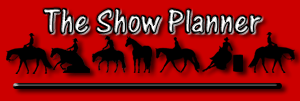INTERPRETING FEED TAGS (part 2)
By Eleanor Richards
Copyright © 2004
Get your feed tag.
Last month we learned why our horse feed is required to have a feed tag. (Click here to read last month's article.) This month we will start to look at the guaranteed analysis and what it does or does not tell us.
The first nutrient listed on the tag is crude protein. Horses need protein for the development and repair of muscle, healthy skin, hair, hooves, milk production, reproduction, and maintaining healthy red blood cells and bones. Notice the list does not include weight gain or energy.
Here are the minimum daily crude protein requirements for several classifications of horses:
Mature idle horses 8.5%
Pregnancy (last 90 days) 11.0%
Lactation 14.0%
Foals 18.0%
Weanlings 16.0%
Yearlings 13.5%
2-year olds 10.0%
Performance 10.0%
It seems pretty simple doesn't it? If you have a performance horse you just buy a feed that has 10% protein. But, there are several catches.
These are percentages. You need to average in the protein of the hay in addition to the protein of the grain or concentrate.
For example:
Your performance horse is consuming 5 pounds of the 10% grain per day. He is also eating 15 pounds of 1st cutting grass hay that tested 6% crude protein. Now for the math (don't cringe - it's easy).
Take the 5 (pounds of grain he is eating each day) times the 10 (protein percent of the
grain): 5 x 10 = 50.
Now take 15 (pounds of hay) times 6 (protein percent of the hay): 15 x 6 = 90.
Add the 50 and the 90: 50 + 90 = 140. Units of protein each day: 140
Now add the total pounds of feed being fed each day: 5 + 15 = 20. Pounds of feed
being consumed each day: 20.
Next divide 140 by 20: 140 ÷ 20 = 7. Your performance horse is only receiving 7%
protein in his overall diet. It's a little short. Hint: get your hay tested and weigh your
feed!
The next problem with the crude protein level on the bag is: how digestible is that protein?
Years ago I read a nutritional study that was conducted on a 2 by 4 piece of wood. It tested at a 12% crude protein level. Purina Mills just tested a concoction they made which consisted of wood chips, clay, 10W40 motor oil and lawn fertilizer. The mixture tested at 14% crude protein level. Are these things able to be digested by horses? No. Are there ingredients in feed that are edible, but the protein cannot be utilized? Yes.
Protein is made up of amino acids. Amino acids are like links in a chain. These links can be in different locations, which result in 22 different amino acids. Some of these amino acids are easier to digest than others.
Lysine is one of the amino acids most recognized by horse owners. It is the first limiting amino acid, meaning if lysine is not available in sufficient quantities the horse will have trouble utilizing the other amino acids present in the diet. Usually if the lysine requirement is being met the other amino acids will be present in sufficient quantities.
Remember you get what you pay for. Protein is the most expensive feed ingredient in a formula. If the product is cheap - the protein source was cheap. The lower the quality of feed the more pounds per day you will have to feed to meet your horse's requirements.
The best source of protein is soybean meal. It is also the most expensive. Soybean meal is rich in lysine and other amino acids. Corn gluten meal, linseed meal, brewer's grain and distiller's grain are examples of inexpensive protein sources, but not easily digested by the horse.
There is not really any benefit feeding more protein than your horse requires. It would be a waste of money and feeding an excessive amount can cause problems.
Some of the protein not needed by the horse may be stored and used as energy. The process a horse uses for storing excessive protein is not efficient. Most of the protein not utilized will be excreted as waste.
Excessive amounts of protein will result in expensive urine and lots of it. In order to purge their system of unwanted protein the horse needs to drink large amounts of water. Horses with a compromised renal system (kidneys) may experience problems while trying to rid their bodies of the protein. Plus the stall will be very wet.
The bottom line is:
1. Be aware of what protein level your horse requires.
2. Offer plenty of good quality forage.
3. Know what the protein level is of the forage.
4. Purchase a good quality product from a reputable company that is designed to compliment the forage you are feeding.
5. Feed according to the feeding directions.
So, the next time you step up to the counter at your favorite feed store and say, "Give me a bag of 12 percent" you'll know what the 12 percent means and if it is really what you want!

